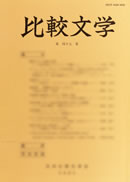Volume 15
Displaying 1-20 of 20 articles from this issue
- |<
- <
- 1
- >
- >|
ARTICLES
-
1972 Volume 15 Pages 1-13
Published: October 31, 1972
Released on J-STAGE: June 17, 2017
Download PDF (5938K) -
1972 Volume 15 Pages 14-24
Published: October 31, 1972
Released on J-STAGE: June 17, 2017
Download PDF (5118K) -
1972 Volume 15 Pages 25-40
Published: October 31, 1972
Released on J-STAGE: June 17, 2017
Download PDF (7356K) -
1972 Volume 15 Pages 158-134
Published: October 31, 1972
Released on J-STAGE: June 17, 2017
Download PDF (10566K)
NOTES
-
1972 Volume 15 Pages 43-53
Published: October 31, 1972
Released on J-STAGE: June 17, 2017
Download PDF (4978K) -
1973 Volume 15 Pages 54-62
Published: October 31, 1973
Released on J-STAGE: June 17, 2017
Download PDF (3914K)
-
1972 Volume 15 Pages 63-92
Published: October 31, 1972
Released on J-STAGE: July 31, 2017
Download PDF (12147K)
-
1972 Volume 15 Pages 93-94
Published: October 31, 1972
Released on J-STAGE: July 31, 2017
Download PDF (848K) -
1972 Volume 15 Pages 94-96
Published: October 31, 1972
Released on J-STAGE: July 31, 2017
Download PDF (1387K) -
1972 Volume 15 Pages 96-97
Published: October 31, 1972
Released on J-STAGE: July 31, 2017
Download PDF (873K) -
1972 Volume 15 Pages 97-99
Published: October 31, 1972
Released on J-STAGE: July 31, 2017
Download PDF (1255K) -
1972 Volume 15 Pages 99-101
Published: October 31, 1972
Released on J-STAGE: July 31, 2017
Download PDF (1251K) -
1972 Volume 15 Pages 102-104
Published: October 31, 1972
Released on J-STAGE: July 31, 2017
Download PDF (1283K) -
1972 Volume 15 Pages 104-105
Published: October 31, 1972
Released on J-STAGE: July 31, 2017
Download PDF (846K) -
1972 Volume 15 Pages 105-107
Published: October 31, 1972
Released on J-STAGE: July 31, 2017
Download PDF (1286K) -
1972 Volume 15 Pages 107-108
Published: October 31, 1972
Released on J-STAGE: July 31, 2017
Download PDF (814K) -
1972 Volume 15 Pages 109-110
Published: October 31, 1972
Released on J-STAGE: July 31, 2017
Download PDF (810K) -
1972 Volume 15 Pages 110-115
Published: October 31, 1972
Released on J-STAGE: July 31, 2017
Download PDF (2486K) -
1972 Volume 15 Pages 115-118
Published: October 31, 1972
Released on J-STAGE: July 31, 2017
Download PDF (1773K)
-
1972 Volume 15 Pages 133-129
Published: October 31, 1972
Released on J-STAGE: July 31, 2017
Download PDF (1706K)
- |<
- <
- 1
- >
- >|
